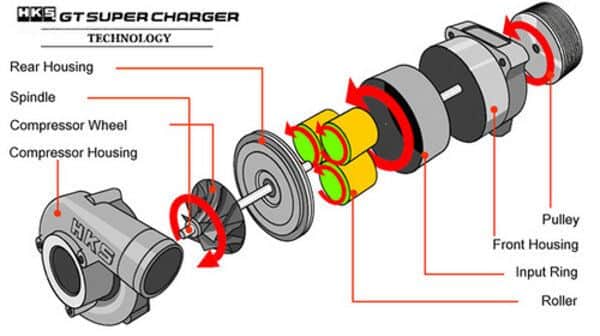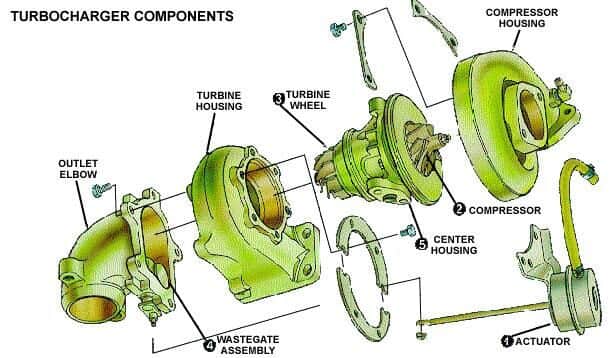In this article, in addition to examining the difference between turbocharger and super turbocharger engines, we also state their advantages and disadvantages.
The difference between supercharging and turbocharging is very simple. The supercharger gets its energy directly from the engine itself (with belts that are directly connected to the flywheel), but turbochargers get their energy from the pressure of exhaust gases from the engine.
The turbocharger is a centrifugal pump that is used by the exhaust gases obtained from combustion and sends more mixture of air and fuel to the engine, which causes more pressure and higher power of the engine.
In the supercharger, two vane wheels are installed at both ends of an axle, one of which acts as a turbine and the other acts as a compressor, in such a way that the combustion fumes coming out of the engine enter the turbine and make it They circulate from the resulting circulation of the compressor, which is located in one direction on an axis, and brings in fresh air and compresses it.
Due to the high input boost pressure produced by the turbocharger, it sometimes causes destruction and damage to the engine components. To control this, the turbochargers are equipped with an exhaust duct. This control valve opens when the boost pressure increases. The smoke is sent to the outside instead of being directed to the turbine and controls its rotation.
Of course, in new engines that are equipped with an ECU or electronic control unit, this is controlled by a sensor in the fuel manifold, which prevents the increase in pressure with a more accurate measurement and controls it by transmitting a signal to the ECU. slow

One of the problems that exist in the operation of the turbocharger is the increase in temperature, which slows down the operation of the turbocharger, and to prevent this, the intercooler, which is a cooler to reduce the temperature of the compressed air, is used, among its other advantages. In addition to cooling the intake air, it lowers the thermal load of the engine and also reduces the temperature of the exhaust gases, which greatly helps in fuel consumption.
In turbo chargers, there are moving vanes that open and close according to the needs of the engine, and in the engines that are equipped with ECU, this is controlled by magnetic valves and they are commanded, therefore, with low and high engine speed, the vane He pointed out the advantages of this mechanism of producing high torque at low engine speeds and reducing fuel consumption.
The supercharger is different from the turbocharger and the way they work is different from each other. The turbocharger works by using the exhaust gases, but the supercharger is mechanically powered by a belt or chain from the crankshaft directly, despite this, by pressing the pedal. Gas superchargers in internal combustion engines are driven by belts.

Pay attention to the connection point of the belt in the photo on the left (supercharger) in front of the connection point to the output manifold in the photo on the right (turbocharger)
The supercharger coupling can be either fixed or provided through a clutch. The Roots supercharger has two rotors and each rotor has two or three protrusions that are either flat or spiral. The chain takes the driving force from the engine, which due to the small diameter of the gear wheel and the supercharger head belt, its circumference is three to four times that of the engine. Using the supercharger when the engine is under full load reduces the engine power, which is To solve this problem, in most superchargers, an electronic clutch is used to move in harmony with the pressure applied to the engine.
In general, turbo chargers and superchargers, in addition to increasing the output power of the engine and increasing their torque, have a positive effect on the consumption of gasoline or fuel, and also reduce the pressure on the engine, which in itself causes lower wear and longer life of its components. Of course, it should not be said that the installation and operation of turbocharger and supercharger requires high level of knowledge and if in other times when the manufacturers themselves do this freely and without the necessary information and with different brands, we will do this with many problems and We may face danger.
Anyway, turbo chargers and super chargers, in addition to increasing the output power of the engine and increasing their torque, make it possible to save gasoline, diesel and fuel, and most importantly, prevent the pressure on the engine, which itself causes low The coming wear and longer life of its components.

It goes without saying that the installation and operation of turbocharger and supercharger requires a high level of expertise, and if we do this freely and without the necessary information and with different brands in other times when the manufacturers themselves do it, we will have many problems and It can even be dangerous.

What is the advantage of compressing engine air?
This is that the engine injects more air into the cylinder. More air intake means more fuel in the cylinder, so you get more power in each explosion from each cylinder. The presence of a turbo/supercharger in the engine produces more power than The engine is in a state without a supercharger. The amount of turbo/supercharger boost is 6 to 8 pounds per square inch (psi). We know that the normal atmospheric pressure at sea level is 14.7 psi. As a result, we find that The turbo/supercharger sends 50% more air into the engine and cylinder. So you expect 50% more power than normal. But it doesn't reach this amount completely, but it improves between 30 and 40%. The main difference between turbo/supercharger is in the place of their energy supply. The same energy that compresses the air. In the supercharger, energy supply is done by a belt that is directly connected to the engine. Like the water pump and generators in the car engine, which get their energy in the same way. In the turbocharger, this energy is provided by the gases coming out of the exhaust. These gases move the turbine with their speed and pressure, and as a result, the turbine also moves the compressor, which compresses the air.
What is the difference between a supercharger and a turbocharger?
The turbocharger is a smart design in this way that it works by using the exhaust smoke from the engine and therefore has a higher efficiency than the superchargers. Because it uses the wasted energy and the exhaust smoke to supply its energy, but the turbocharger causes It is possible that some back pressure is created in the exhaust system, and this back pressure can reduce the efficiency of the turbo charger as long as the engine is running at high speed.
An increase in temperature, which in turn slows down the work of the turbocharger, and to prevent this, an intercooler is used, which is a cooler to reduce the temperature of the compressed air. It has other advantages besides cooling the intake air, lowering the load. The heat of the engine, as well as the reduction of the temperature of the gases coming out of the exhaust, helps significantly in fuel consumption.
Installing superchargers is easier but expensive.
In turbo chargers, as the name suggests, there is a small turbine with movable vanes that open and close according to the engine's needs. In engines that are equipped with ECU, this is controlled and controlled by magnetic valves. Therefore, with low and high engine speed, the vanes are closed. He pointed out the advantages of this mechanism of producing high torque at low engine speeds and reducing fuel consumption.
The supercharger is different from the turbocharger and the way they work is different from each other. The turbocharger works by using the exhaust fumes. Pressing the gas pedal, superchargers in internal combustion engines are driven by a belt.
Coupling of the supercharger can be provided both through the clutch and the Roots supercharger has two rotors and each rotor has two or three protrusions that are either flat or spiral. The rotors are engaged by the gear and by The belt or chain takes power from the engine, which due to the small diameter of the gear wheel and belt wheel of the supercharger, its circumference is three to four times that of the engine. Using the supercharger when the engine is under full load reduces the engine power. To solve this problem, in most superchargers, an electronic clutch is used to move in harmony with the pressure applied to the engine.
